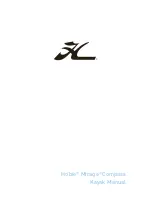
4-4
Section 4
Electrical System
C230
ACC
This is an open switch and reserved for
future additional accessories. DO NOT
exceed 10 amps.
4.4 Electrical System
Maintenance
12-Volt DC Electrical System
Maintenance
Semi-annually spray all exposed electrical
components behind the helm and in the
plugs with a protector specific for electrical
connections. Exterior light fixture bulbs
should be removed and the metal contact
areas coated with a non-water soluble lubri-
cant like petroleum jelly or silicone grease.
The sockets should be sprayed with a pro-
tector. DO NOT get any oil or petroleum jelly
on the glass portion of the bulbs, this will
cause the bulb to overheat and burn out.
Make sure to check that all below deck wir-
ing is properly supported, the insulation is
sound and there are no loose or corroded
terminals. Clean any corroded terminals
thoroughly with sandpaper, or replace them.
Tighten securely and spray with a metal and
electrical protector. Inspect all engine wiring.
Check the electrolyte level in the batteries
regularly and add distilled water as neces-
sary. If the batteries are frequently charged
by a battery charger, check the electrolyte
level more often. The correct fluid level in the
cells is approximately ¼ to ½ inch above the
plates. If fluid is needed, fill to the proper
level with distilled water ONLY. DO NOT
overfill. Some batteries are sealed and can-
not be filled.
Keep the tops of any battery clean and dry.
Dirt and water can conduct electricity from
one post to the other and can cause battery
discharge or cause errant engine warnings.
Keep the battery posts free of corrosion. DO
NOT use wing nuts to attach battery cables.
Remove the cables and clean the posts and
cable clamps with a battery post cleaner or
sandpaper as required. Coating the battery
posts and cable clamps with petroleum jelly
or silicone grease will help protect and
reduce corrosion. Battery cables, both posi-
tive and ground must be replaced when they
show signs of corrosion or fraying. Deterio-
rated cables cause a considerable voltage
loss when high currents are drawn, as for
starting the engine.
!
DANGER
Contact with an energized AC or DC
can cause death or serious injury. DO
NOT inspect or service an energized
electrical system. Disconnect the AC
and DC electrical system power
source.
!
CAUTION
Use exact replacement light bulb; a
different bulb can cause fixture to
overheat, melt or short circuit.
!
DANGER
FIRE OR EXPLOSION HAZARD
Explosion or fire from hydrogen gases
produced by lead acid batteries will
cause death or serious injury. DO NOT
smoke or bring a flame near battery
storage area. If ignited by a spark or
flame, gas may explode violently,
causing spraying of battery acid or
fragmentation of the battery.
Содержание C 230
Страница 12: ...Operator Notes 8 C230...
Страница 22: ...Operator Notes 2 6 C230...
Страница 38: ...6 2 Operator Notes C230...
Страница 44: ...8 2 Operator Notes C230...
Страница 76: ...12 6 Operator Notes C230...
Страница 82: ...Operator Notes A 6 C230...
Страница 84: ...Appendix B Maintenance Log Date Hours Dealer Service Repairs B 2 C230 Maintenance Log...
Страница 85: ...Maintenance Log B 3 Appendix B C230 Date Hours Dealer Service Repairs...
Страница 86: ...Appendix B Maintenance Log Date Hours Dealer Service Repairs B 4 C230...
Страница 87: ...Boating Accident Report C 1 Appendix C C230 Boating Accident Report...
Страница 88: ...C 2 Appendix C Boating Accident Report C230...
Страница 89: ...Float Plan D 1 Appendix D C230 Float Plan...
Страница 90: ...Operator Notes D 2 C230...
Страница 94: ...Operator Notes E 4 C230...
Страница 95: ...Schematics F 1 Appendix F C230 Schematics...
Страница 96: ...F 2 Appendix F Schematics C230 C 230...
Страница 97: ...Schematics F 3 Appendix F C230 C 230...
Страница 98: ...F 4 Appendix F Schematics C230 C 230...
Страница 99: ...Schematics F 5 Appendix F C230 C 230...
Страница 100: ...Operator Notes F 6 C230...
Страница 101: ......
Страница 102: ......
















































